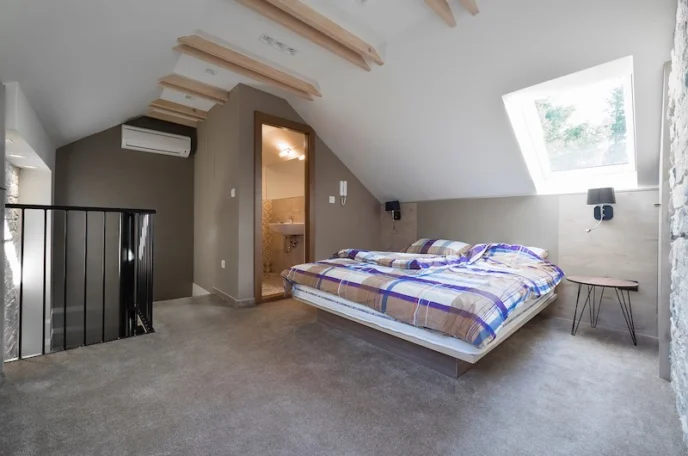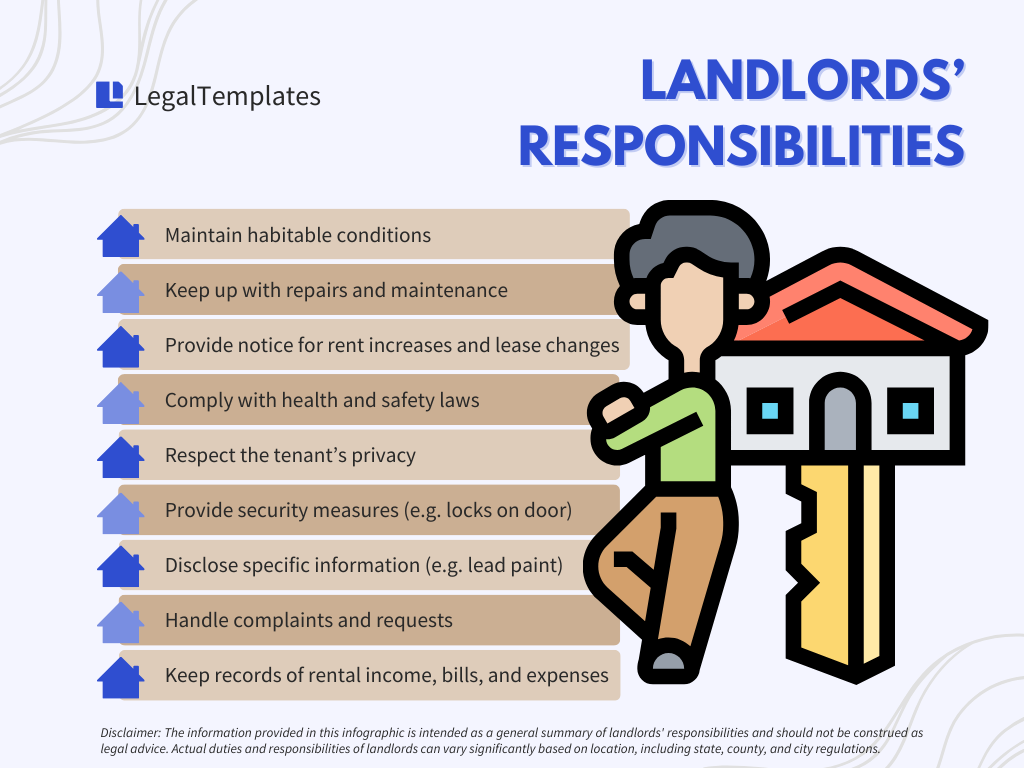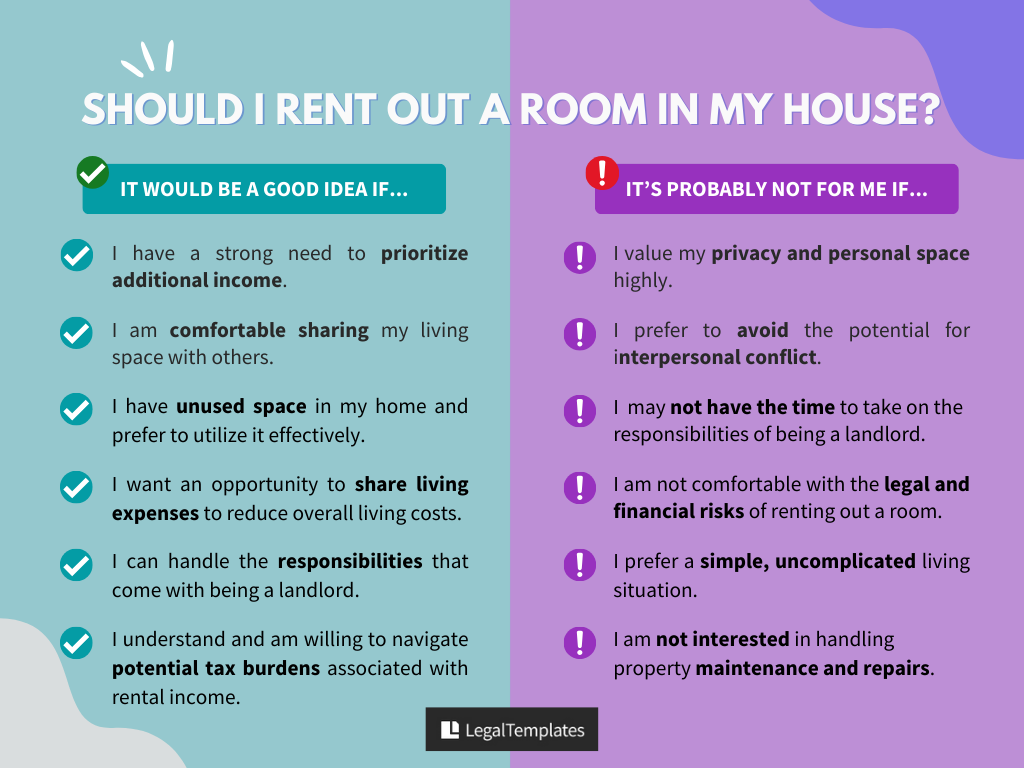
If you are a homeowner with extra space in your house, renting out a room to collect rent may seem like an enticing option to earn extra cash.
Renting out a room on your property requires careful consideration of legalities, financial implications, and interpersonal dynamics.
To help keep you out of potential legal trouble and start earning passive income, here are the complete steps to rent out a room in your house.
Note
If you’re a tenant looking to rent out a room on your current property to a new occupant, check our subleasing guide instead.
- Step 1: Understand Landlord-Tenant Laws
- Step 2: Check with Your Insurance Provider
- Step 3: Decide Which Room to Rent
- Step 4: Determine the Rent Amount
- Step 5: Prepare Your House
- Step 6: Make Your Listing
- Step 7: Screen the Tenants
- Step 8: Sign an Agreement
- Step 9: Document Income and Expenses
- Step 10: Actively Manage Your Rental Property
- Summary
Step 1: Understand Landlord-Tenant Laws

Once you rent a room to another party, you have established a landlord-tenant relationship. Understanding the landlord-tenant laws in your state and local area is the first step to a successful rental experience.
Landlord-tenant laws cover a wide range of topics, including the rights and responsibilities of both landlords and tenants, eviction procedures, security deposit regulations, and more. Specifically, these laws generally require the landlord to:
- Maintain habitable conditions. You must ensure the rental property is habitable and meets basic structural, health, and safety standards. This includes adequate water supply, heating, electricity, sanitation, and maintenance of common areas.
- Keep up with repairs and maintenance. You will be responsible for keeping the property in good repair. This includes fixing any issues with essential services (like plumbing, heating, and electricity) and addressing any wear and tear that impacts the tenant’s ability to use the property as intended.
- Provide security measures. These include locks on doors and windows to ensure the tenant’s safety.
- Comply with health and safety laws. You must comply with local health and safety laws, including regulations on lead paint, asbestos, mold, and pest control.
- Respect the tenant’s privacy. While you have the right to access the tenant’s private living space for inspections, repairs, and maintenance, most state laws require you to provide notice (often 24-48 hours, depending on your state) before entering, except for emergencies.
- Provide notice for rent increases and lease changes. Most states require landlords to provide tenants with advance notice of rent increases or changes to the lease terms. Clarify how rent increases or lease term changes need to be addressed in your room rental agreement.
- Disclose specific information. You may be required to provide tenants with specific information, such as lead paint disclosures, the identity of the property owner and property manager, and information about where the security deposit is held.
- Handle complaints and requests. You must responsibly and promptly address complaints and repair requests from tenants.
- Keep records. Maintaining records of all rental income, expenses, deposits, repairs, complaints, and room rental agreements.
In addition to landlord-tenant laws, you should also learn about your local laws and regulations, as there may be restrictions around renting rooms in your house, such as from your neighborhood association or your co-op board.
Step 2: Check with Your Insurance Provider
Like mortgage lenders, most homeowners insurance companies request that you inform them before renting a room in your house.
Note that basic homeowners insurance often does not provide adequate protection from any damages caused by a renter, as your property no longer qualifies under an owner-occupied or single-family insurance policy.
Look into landlord insurance coverage. It can cover the cost of repairs to your home or lost possessions while allowing you to recover any outstanding rent payments. In addition, it acts as liability insurance in the event of personal injury to your tenant and will help you offset legal fees should you ever be sued.
If you’d like to take additional precautions, ask your tenant to apply for renters insurance. It can be taken out in your tenant’s name and will protect their personal belongings in case of any accidents (e.g., a fire).
Step 3: Decide Which Room to Rent
While renting out a room in your property has certain benefits, it has some downsides you should consider.
Pros
- Additional income
- Utilization of unused space
- Shared living expenses
- Companionship
Cons
- Loss of privacy
- Potential for conflict
- Management responsibilities
- Legal and financial risks

Consider Your Ideal Tenant
There are two main ways to rent out space in your house: to a lodger or to a roommate.
- Renting to a Lodger: If you live in a house and lease one of its rooms to another individual, that individual is considered a lodger. The lodger typically has a lease agreement with you, but their rights and responsibilities may differ slightly from a traditional tenant.
-
Roommate: This term is often used more informally when people share an apartment or house together. They may or may not be the legal tenants on the lease.
Step 4: Determine the Rent Amount
It can be challenging to know exactly what rent price you should set for a room, but generally, asking for an amount similar to your area’s current fair market value will increase your chances of successfully renting a room.
Using sites like Craigslist, Zillow, or Trulia, try to find similar rental rates for single rooms in your vicinity.
Compare several factors when determining the rent:
- Total monthly mortgage payment (if applicable);
- Monthly homeowners insurance premiums;
- The cost of utilities;
- Square footage of the room for rent and common areas;
- Any desirable amenities, such as a swimming pool.
Check local, state, and federal laws for rules on obtaining security deposits from tenants, notices of rent increase, lease termination, and other legal issues that may arise when renting a room.
Additionally, offering various payment methods for rent can help tenants meet their obligations on time and reduce the risk of late payments.
Rent Control
Some areas have enforced rent control laws, which limit the amount of rent landlords can charge or increase. As of 2024, California and Oregon have implemented statewide rent control laws.
Step 5: Prepare Your House
The next step in successfully renting a room in your house is to ensure that the entire property is in good shape and take the proper precautions.
The room should be as presentable as possible, and the home should be welcoming and well-kept.
Ensure you take care of any repairs or modifications before showing the room, which can include:
- Painting the walls;
- Cleaning all floors or carpets;
- Checking that all electrical outlets work;
- Replacing batteries in the smoke detector;
- Inspecting all windows and doors;
- Installing locks on both the tenant’s room and rooms deemed “off-limits” to the tenant (e.g., child’s bedroom)
Additionally, take stock of any personal possessions or valuable items and ensure they are safe and secure.
Be sure to inform all household members before scheduling room viewings so they are aware and can make accommodations if necessary.
Step 6: Make Your Listing
While federal fair housing laws prohibit discrimination, renting a room in your house is a slightly different affair and doesn’t entirely fall under the standard purview.
Unlike renting a house, you can include language in your room rental listing that specifies a preference for someone of a particular gender.
For example, a female wishing to rent a room in their home to another female is within their right to deny a male tenant. However, if you deny a tenant for a specific reason, you must do the same for all tenants.
Various rental listing sites make advertising your short-term or long-term room for rent easier.
- Airbnb – While it may be the go-to service for vacation lodging, it allows homeowners to showcase their homes to a wide-reaching audience of potential short-term renters. Keep in mind that most users seek nightly accommodations.
- Trulia – An online real estate database. Homeowners can easily connect with renters seeking long-term room rentals.
- Roomster – Homeowners can create a listing for long-term room rentals in less than a minute.
Step 7: Screen the Tenants
Screening prospective tenants and conducting background checks are necessary for any rental process.
Once you’ve shown them the room, have them fill out a standard rental application. The primary purpose of this application is to verify the tenant’s rental history, employment, and financial status. Combining a thorough application process with credit and eviction checks, you can better ensure that you select a reliable and respectful tenant.
Ideally, you want to find a tenant who can:
- Pay rent on time;
- Respect your personal space and boundaries;
- Maintain cleanliness and order in both their private and shared spaces;
- Communicate effectively and constructively address issues or concerns;
- Demonstrate stability, such as having a steady job or reliable source of income;
- Adapt well to living in a shared environment.
You should request copies of their driver’s license and social security card and obtain their authorization to run a criminal background check.
Requesting a nonrefundable fee to process the background check is standard practice.
► READ MORE: Top 10 Red Flags on Rental Applications
Step 8: Sign an Agreement
You and your tenant should sign a room rental agreement stipulating the rental term and the monthly rent amount, among other terms.
When creating your room rental agreement, consider including the following in addition to the typical terms and conditions:
- Clarifications on utility payments: State clearly which utilities (electricity, gas, water, internet, cable, etc.) are included in the rent and which ones the tenant is responsible for.
- Definitions of common areas: Specify which areas of the house are common areas (like the kitchen, living room, and bathroom) and any restrictions or rules regarding their use.
- House rules: Include specific house rules covering issues such as noise levels, quiet hours, smoking, alcohol use, completion of various chores or tasks, and any other relevant living guidelines.
- Maintenance and repair terms: Outline the tenant’s responsibilities for maintenance and repairs in their rental space, and specify how repair requests should be submitted.
- Guest policies: Specify any rules regarding guests, including how often the tenant may have guests, limits on how long guests can stay, and the number of guests allowed.
- The tenant’s emergency contacts: In case anything happens, you should know who to contact.
- Eviction causes and process: Outline the actions that may result in you having to evict your roommate and detail the notice period and process for evictions.
Step 9: Document Income and Expenses
While renting out a room in your house may generate extra income, you may be shouldering new tax burdens.
The IRS considers rental income taxable income, which means you’ll need to report your rental income on your tax return. In the meantime, you may also be able to deduct certain expenses associated with your rental property, such as repairs, insurance, and depreciation.
What Counts as Rental Income
Remember, all income received as rent must be reported. This may include regular rent payments and other forms of rental income, which can include:
- Advance Rent: Include any advance rent received in your income for the year you receive it, regardless of the period covered.
- Security Deposits: If used as final rent payment, include in income when received. Returned deposits are not included unless they’re kept due to a breach of lease terms.
- Payment for Lease Cancellation: Include it if a tenant pays you a fee to cancel a lease.
- Expenses Paid by Tenant: Deductible if they are regular rental expenses.
- Property/Services as Rent: Include the fair market value of property or services received as rent.
What Counts as Deductible Expenses
Deductible expenses for rental properties may include:
- Mortgage interest, property tax, operating expenses, depreciation, repairs.
- Ordinary and necessary expenses for property management, maintenance, utilities, and insurance.
- Costs for materials, supplies, and repairs to maintain property condition.
- Expenses paid by the tenant if they are deductible rental expenses.
- Depreciation of improvements (using Form 4562).
Costs for improvements and repairs are not immediately deductible but recovered through depreciation.
The IRS also lays out special instructions depending on whether or not you used the dwelling unit (rental property) as your primary residence and how long you rented the home.
| Not used as a home | Used as a home (rented for less than 15 days) | Used as a home (rented for more than 15 days |
|---|---|---|
| Report all rental income | Not required to report rental income and expenses | Report all rental income |
| Divide expenses between personal use and rental use | Divide expenses between personal use and rental use | |
| Deduct all rental expenses if you had a net profit | ||
| Deduction of certain rental expenses are limited if you had a net loss |
Keeping detailed records of rental income and expenses is key to reporting your taxes accurately. Maintain documentary evidence (e.g., receipts, bills) and track travel expenses for property repairs.
You can visit the IRS website for more information.
Check with Your Mortgage Lender
If you are making loan payments on a house, renting a room to someone is a great way to reduce the monthly cost of a mortgage. However, your mortgage lender will often require their consent before you start finding someone to rent your room.
Review your mortgage agreement, as some contain clauses that prohibit renting out part of the property without the lender’s permission. Violating these terms could lead to severe consequences, including foreclosure.
As long as it is your primary residence, renting out part of your home will not negatively impact your mortgage.
Any rental income you receive for renting out a room cannot be used to qualify for a larger loan should you choose to refinance your mortgage.
Step 10: Actively Manage Your Rental Property
Once your tenant has moved in, the process doesn’t end there. Actively managing your rental property is crucial to ensuring a positive experience for both you and your tenant.
1. Regular Communication
Maintain open lines of communication with your tenant. Regularly check in to address any concerns or issues that may arise. Promptly responding to maintenance requests or questions helps to foster a positive landlord-tenant relationship and can prevent small issues from becoming major problems.
2. Routine Inspections
Schedule routine inspections to ensure the room and shared spaces are being maintained properly. These inspections should be conducted respectfully and with prior notice, as agreed upon in the lease. Routine inspections allow you to address any potential damage or maintenance needs early, safeguarding your property’s condition.
3. Maintenance and Repairs
Stay on top of any maintenance needs. Whether it’s a leaky faucet or a malfunctioning appliance, addressing repairs quickly is not only your legal obligation but also helps in keeping the tenant satisfied. Preventive maintenance, such as regularly servicing heating systems or checking smoke detectors, is also essential.
4. Rent Collection
Implement a consistent system for collecting rent. Whether you prefer electronic payments or checks, ensure that your method is reliable and secure. Clearly communicate the rent due dates and any late fees associated with delayed payments to avoid misunderstandings.
5. Enforce Lease Terms
Be diligent in enforcing the terms of the lease agreement. Whether it’s related to rent payments, noise levels, or the use of shared spaces, consistency is key. By adhering to the lease terms yourself, you set an example and create a structured environment for your tenant.
6. Prepare for Tenant Turnover
Even with the best management, tenant turnover is inevitable. When a tenant decides to move out, ensure the process is smooth. Conduct a final inspection, return the security deposit in a timely manner, and prepare the room for the next tenant. This includes thorough cleaning, making necessary repairs, and updating your advertising strategy to attract new tenants.
Summary
Renting a room in a house can be a valuable learning experience for any homeowner interested in property management.
In addition, it’s also a great way to minimize the hefty cost of homeownership and provide a reliable income for you and your family.
